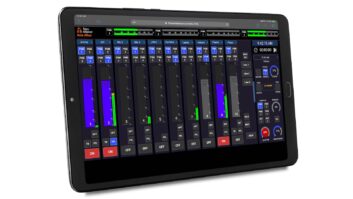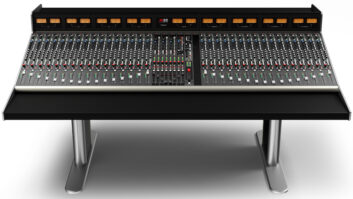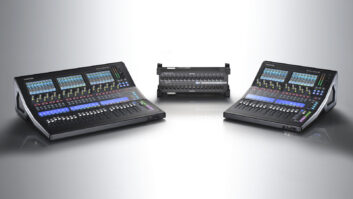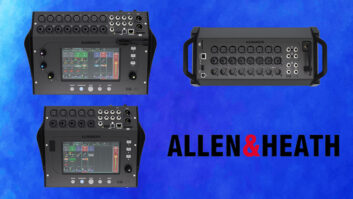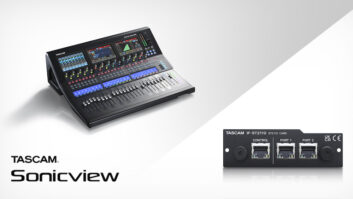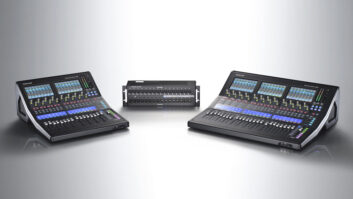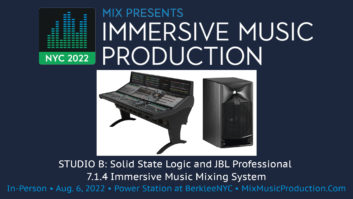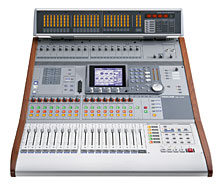
With the DM-3200, Tascam clearly demonstrates how far digital audio has come in the past few years. The DM-3200 incorporates a 48-channel audio mixer and DAW controller, and — with the addition of the IF-FW/DM FireWire interface card — it can function as the audio interface for your DAW. The DM-3200 runs via internal or external clock at sample rates from 44.1 to 96 kHz without sacrificing channels at high-resolution rates. An optional meter bridge provides LED meters for 24 channels, the L/R master bus and a SMPTE timecode counter. Console settings may be stored and recalled using Compact Flash cards or through Tascam’s TMC (Tascam Mixer Companion) software (Mac or PC).
ON THE DESK
The board features 16 channel strips, each with a touch-sensitive, motorized fader; mute, solo and select switches; a rotary encoder; mic/line switch with 20dB pad; and trim control. These strips control 48 input channels in three layers. Additional layers provide access to 16 bus and eight aux outputs or DAW control. Tascam includes DAW profiles for Mackie HUI emulation, MOTU Digital Performer, Cakewalk SONAR, Steinberg Cubase and Nuendo, and Apple Logic, all easily selected from a dedicated Remote screen and stored with project data.
Other front panel controls include switches for screen navigation, C/R source (L/R, aux 1/2, digital in 1, 2-track return), mono sum (thank you), talkback, solo level and an LCD. Four rotary encoders and pushbuttons below the screen facilitate navigation and parameter adjustment. A three-position EQ/Dyn switch reconfigures the 16-channel encoders to form horizontal EQ or dynamics control strips for the selected channel.
EEE! I/O, I/O!
The back of the DM-3200 hosts extensive I/O: Sixteen analog inputs feature XLR mic and TRS line and insert jacks, with phantom power switches in banks of four on the front. Main L/R outs are routed via +4 balanced XLR and -10 RCA jacks. Control room monitor outs are ¼-inch TRS, while studio outs are -10 RCA jacks. Four pairs of TRS send/return jacks may be assigned to any bus or channel as an insert, or they may be used for aux sends and effects returns.
Digital connectivity is equally comprehensive. Three TDIF and an ADAT optical I/O are built in, while two slots accept expansion cards for additional analog or digital I/O. Two stereo digital I/Os each offer AES and S/PDIF connectors, although you can only use one of each type at a time. Cascade ports allow two DM-3200s to be linked, sharing solo, bus, aux and main output paths. Additional ports include USB, word clock I/O, MIDI In/Out/Thru, SMPTE in, Sony 9-pin, ¼-inch footswitch and a connection for the optional MU-1000 meter bridge. The review unit came with the MU-1000 and the IF-FW/DM FireWire expansion card.
EASY TO CONFIGURE IT OUT
One of the DM-3200’s strengths is an extremely flexible routing system that allows any input to be soft “patched” to any console channel. Sixteen bus and eight aux outs may be assigned to any physical output. Between the analog, TDIF, ADAT and card slot I/Os, a multitude of I/Os can remain connected and chosen, depending on the session. When using the DM-3200 for a Pro Tools session, I configured the desk for HUI emulation, ADAT inputs on channels 1 through 8, analog ins on channels 9 through 16, and ADAT outs on buses 1 through 8 for use with a Digi 002. Another project required 24 channels of TDIF I/O, plus analog inputs 1 through 8 patched to channels 33 through 40 as effect returns.
Using the IF-FW/DM with Digital Performer (DP), I created I/O paths between DP and the DM-3200, and used the DP DAW profile for control. Each of these individual system configurations was stored as a project, and switching between them required only a button-push. This is a home run for studios that use various recording formats: Simply recall the project and the routing comes back, along with console settings, libraries and automation data.
I used the IF-FW/DM to interface the DM-3200 to a Mac running DP, providing 24 I/Os at 44.1 or 48kHz sample rates. (The IF-FW/DM does not support 88.2/96 kHz.) Expansion cards automatically appear in the routing screen, where they are treated the same as built-in I/Os. The IF-FW/DM requires an exclusive FireWire bus.
Connecting it to an Adaptec DuoConnect FireWire/USB PCI expansion card in my G4 proved unreliable when opening TMC software: The software launched successfully only 50 percent of the time, and when it did launch, choosing Timecode Window or Meter Bridge under the Windows menu caused the app to crash. Connecting the IF-FW/DM directly to a FireWire port on the Mac solved this issue. TMC is a great addition to the package, enabling project management for multiple DM-3200s via USB, as well as providing a beautiful metering screen.
MIDI OPTIONS
In addition to MIDI In/Out/Thru ports, the DM-3200 has six “virtual” USB MIDI ports, each dedicated to a task. (Although the manual says MIDI is recognized by the IF-FW/DM card, it is not at this time.) Port 1 is used exclusively for TMC, and port 3 is reserved for MTC. When you add the DM-3200 to the Mac’s AudioMIDI Setup, six ports are displayed. Ports 5 and 6 are used for Mackie Control and Mackie Control EXP, respectively, to facilitate MMC and DAW control. Neither of these carries timecode, so I had to add another Mackie Control device to AMS and then patch it to the DM-3200’s port 3, after which the desk received timecode via USB.
EQ AND EFFECTS
Channels 1 through 32 include EQ, dynamics, phase reverse, aux, assignable inserts, direct out and bus assignment. (Channels 33 through 48 don’t feature EQ, dynamics and phase reverse, so they’re more appropriate for effect returns.) EQ is 4-band and fully parametric, with each band capable of sweeping from 31 to 19k Hz. Low and high bands may be changed to shelf-type or filters, in which case, the bandwidth control is grayed out. I found the EQ section very versatile, capable of creating subtle bumps, as well as surgical notches or peaks.
Dynamics include a compressor and gate per channel, each with some cool features. The compressor can be “patched” pre- or post-EQ, while the gate features a hysteresis parameter to reduce chatter. (This feature worked quite well on toms.) Dynamics may be stereo-linked to a neighbor channel or triggered from any channel. Because a single input may be soft-patched to more than one channel, it’s easy to create a sidechain for de-essing by adjusting the EQ on one channel and using it to trigger the audio of another — very slick. At lower ratios, compression was transparent, but once you wind it up, it can get squashy, which is not necessarily a bad thing, depending on your tastes.
A dedicated screen mode key provides quick access to two internal effects engines that can generate just about any effect you might want, including delay, reverb, chorus, de-esser, distortion and a TC Works reverb.
AUTOMATION
The DM-3200 incorporates extensive snapshot and timecode-based dynamic automation that includes write, trim, safe and off for fader, mute, pan, EQ, comp/exp and aux levels; these may be selected globally (all modules) or individually. When the DM-3200 has locked to code, an indicator lights and the meter bridge displays running timecode. Automation controls on the front include write, trim, rehearse and revert, making operation very simple. To write moves or mutes, run timecode, press Write and have at it. The DM-3200’s auto-store option includes a preference for either overwriting the previous mix or keeping the previous mix as a backup.
ACCESSORIZE?
If you’re used to other Tascam products in the company’s digital line, then you know there are a lot of I/O and other options at your disposal. For instance, with the DM-3200, there is an 8-channel balanced analog card (IF-AN/DM), an 8-channel TDIF digital card (IF-TD/DM), an 8-channel ADAT digital card (IF-AD/DM), an 8-channel AES/EBU digital card (IF-AE/DM), FireWire interface card (IF-FW/DM) or the very slick surround monitor card (IF-SM/DM), which is basically Tascam’s DS-M7.1 monitor box on a card. This would give you the ability to turn the console into a complete surround workstation with monitor control and much more.
IN YOUR EAR
The DM-3200’s mic pre’s are clean and quiet with a surprising amount of low-frequency extension. The desk worked flawlessly and sounded great at high-res sample rates, but keep in mind that certain interfaces (e.g. TDIF-1) lose half their channels to route high-res data. This is not a reflection of the DM-3200’s capabilities, but the nature of the protocol. The L/R mix bus has plenty of headroom; connectivity should satisfy any gear junkie, and the controls feel solid.
Other than that, my gripes about the DM-3200 are nit-picky: My version of the software CD did not include documentation for AMS configuration with DP, the automation manual or TMC for Mac; these had to be downloaded from the Website. [Eds. note: Tascam says this documentation has since been added to the installer CD.] When linking a pair of channels, the panners are automatically split hard-left and hard-right, and pan control on the front then becomes a stereo balance control. There is also a Stereo Width control on the Channel page that gives you additional panning options, including the ability to swap left and right. And it would be nice to have a discrete volume control for the studio outs, which follow the volume of C/R out via software trim control.
Other than that, this desk is amazingly full-featured for its price range. Its I/O is extensive, and the fact that you don’t lose channels when you up the sample rate is a real plus. Adding the optional meter bridge and FireWire card makes it even more versatile and attractive to anyone looking for a DAW companion. Other notable features such as TC Electronic reverb, an easy-to-use OS and CF storage add up to a tremendous deal.
Price: $2,999.
Tascam, 323/726-0303, www.tascam.com.
Steve “Woody” La Cerra is Mix’s sound reinforcement editor.
